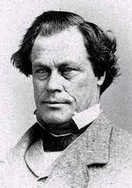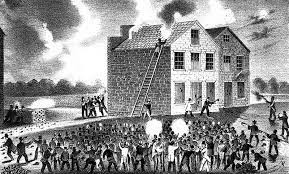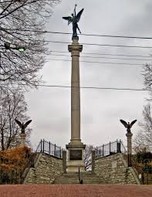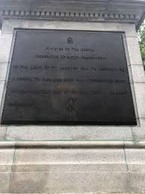Elijah P. Lovejoy Monument
Introduction
Text-to-speech Audio
Dedicated in 1897, this monument honors the martyr for the abolitionist cause, Elijah P. Lovejoy, who was killed in 1837 while defending his newspaper office against a mob. Not only did Lovejoy fight for abolition, but he also famously fought for the freedom of speech and freedom of the press through his various publications and news outlets, ultimately leading to his death in a riot enacted against his printing press. While abolitionists had suffered attacks before, Lovejoy became the cause's first well-known white martyr. Far from having the effect proslavery forces hoped for, Lovejoy's martyrdom motivated anti-slavery activists to fight harder to end slavery, and it signaled a new phase in the struggle against the institution of slavery. The event inspired a young Whig lawyer named Abraham Lincoln to publish a controversial speech decrying mobocracy, a cautious but essential step on a path that saw Lincoln push the center of the Republican Party towards the more liberal views of its anti-slavery supporters.
Images




Backstory and Context
Text-to-speech Audio
Elijah Parish Lovejoy, the martyred abolitionist who died in defense of his press and the freedom of speech, was born on November 9, 1802, in Albion, Maine. Lovejoy’s father was a congregational preacher and farmer, and his mother was a homemaker and devout Christian. He completed his early studies and attended the private Academy at Monmouth (Maine) and the China Academy (Kennebec County, Maine). He then enrolled at Waterville College (now Colby College), graduating cum laude in 1826.
In 1827, Lovejoy arrived in St. Louis, Missouri, which then identified itself less with the plantation South and more as the “gateway to the West.” Initially, Lovejoy ran a private school in St. Louis and published poetry in local newspapers. Not able to attract many subscribers to the private school, Lovejoy then turned to publishing a newspaper to earn money. In 1829, Lovejoy became co-editor with T. J. Miller of the St. Louis Times.
After attending a Christian revivalist meeting led by abolitionist David Nelson, Lovejoy joined the First Presbyterian Church and became a firm believer in an evangelical mission. Lovejoy returned to the East for religious training and became an ordained minister of the Presbyterian Church in Philadelphia in 1833. Friends in St. Louis offered to finance a religious newspaper if Lovejoy would return and be its editor. Lovejoy agreed and became editor of the new St. Louis Observer.
By 1834, the St. Louis Observer grew increasingly anti-Catholic and anti-slavery in its editorials. Over time, Lovejoy’s outspoken views on Catholicism were criticized, but it was his advocacy of abolition that brought threats of violence. The newspaper suffered vandalism repeatedly, and after a failed kidnapping attempt, Lovejoy decided to move to Alton, Illinois in 1836. A year later, Lovejoy started the Alton Observer. He also became the first pastor of Upper Alton Presbyterian Church, later named the College Avenue Presbyterian Church.
Lovejoy’s uncompromising religious zeal, coupled with his stand for immediate abolition, angered and frightened many of Alton’s citizens. On two separate occasions, mobs destroyed Lovejoy’s printing press in an effort to silence his incessant agitation of the slavery question. On October 25, 1837, Lovejoy held a meeting in the church to form the Anti-Slavery Society in Illinois. In response, a riot erupted, threatening the people inside the church. The meeting moved across the street to the Old Rock House the following day. On November 7, 1837, an angry mob gathered and attempted to throw Lovejoy’s printing press into the Mississippi River. Elijah Lovejoy lost his life trying to defend his printing press.
Buried in Alton Cemetery, Lovejoy’s grave was left unmarked in hopes of preventing vandalism for the first few decades after his death. In 1897, the editor of the Alton Democrat, Thomas Dimmock, worked to finalize a memorial that commemorated the life of Lovejoy. The Elijah P. Lovejoy Monument stands over ninety-three feet tall and features a seventeen-foot-tall bronze statue on top. R.P. Bringhurst, a sculptor from St. Louis, designed the monument, and Culver Stone Company from Springfield, Illinois, constructed it. On the monument's column lies winged statues, representing the idea of a triumphant goal, such as the end of slavery.
A recovered piece of one of Lovejoy’s printing presses is on display at the Alton Telegraph’s office. The Hayner Library in Alton has an excellent Lovejoy Collection that includes parts of one the printing presses thrown into the Mississippi River. In addition to the books, artifacts, and primary source materials, the Hayner Library also has a short documentary film on the life and legacy of Elijah Lovejoy. The Mythic Mississippi Project produced the film with the University of Illinois, Urbana-Champaign.
Sources
Voigt, Jason. College Avenue Presbyterian Church and the Old Rock House The Anti-Slavery Society Is Born, Historical Marker Database. November 15th, 2019. Accessed November 26th, 2022. https://www.hmdb.org/m.asp?m=144833.
Voigt, Jason. Elijah Parish Lovejoy, Historical Marker Database. November 4th, 2019. Accessed November 26th, 2022. https://www.hmdb.org/m.asp?m=142159.
Elijah P. Lovejoy Monument, Great Rivers and Routes of Southwest Illinois. Accessed November 26th, 2022. https://www.riversandroutes.com/directory/elijah-p-lovejoy-monument.
Madison County Historical Society News, Vol. 1, No. 2 (2013), https://madcohistory.org/wp-content/uploads/2019/10/2013-Vol1-No2-Mar-Emancipation-Slavery-.pdf
Elijah Parish Lovejoy, Wikipedia. November 15th, 2022. Accessed November 26th, 2022. https://en.wikipedia.org/wiki/Elijah_Parish_Lovejoy#Early_life_and_education.
Eldridge, Alison. Elijah P. Lovejoy, Britannica. November 5th, 2022. Accessed November 26th, 2022. https://www.britannica.com/biography/Elijah-P-Lovejoy.
